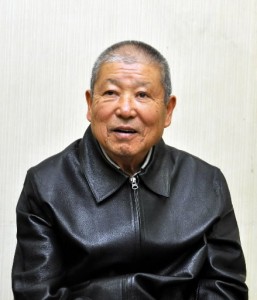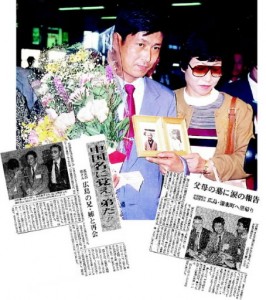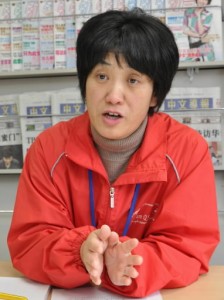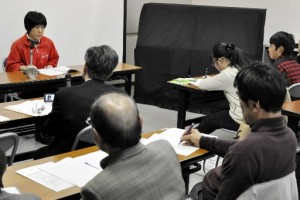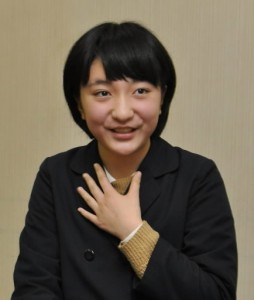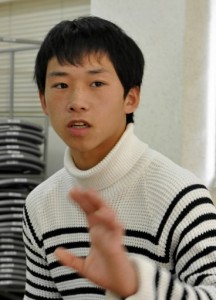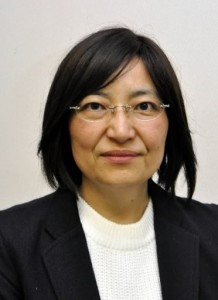Peace Seeds: Teens in Hiroshima Sow Seeds of Peace (Part 40)
Jan. 19, 2017
Part 40: Japanese war-displaced orphans left in China forge new lives in Japan
Have you heard of “Japanese war-displaced orphans left in China”? This refers to children younger than 13 at the time they were forced to stay in the former Manchuria (in northeastern China) after the Pacific War ended in August 1945. Amid chaotic conditions, they were left there because they had lost one or both parents, then were raised by Chinese people.
The Japanese government began to help the Japanese war-displaced orphans return to Japan when diplomatic relations with China were restored in 1971. It was not until 1981, however, that these people were able to visit Japan to search for their roots and meet relatives. Even when they were able to realize their dreams and return to Japan, at that point they were already middle-aged or older. They faced difficulties communicating with others in Japan and finding work due to their lack of Japanese language ability.
According to the Ministry of Health, Labour and Welfare, 2,818 people were identified as Japanese war-displaced orphans left in China as of the end of 2016. Among them, 2,556 people have returned to Japan to reside permanently. How are the generations of family members now faring, the orphans in their old age, the children who support them, the teenage grandchildren, and even some great-grandchildren? Peace Seeds interviewed them to find out.
Mitsuyuki Teraoka, a Japanese war-displaced orphan, returns to Japan from China
Mitsuyuki Teraoka, 72, a resident of Naka Ward, said in Chinese, “My neighbors think of me as Chinese. This can’t be helped, though.” It has been 30 years since his Japanese roots were identified, but he is still unable to speak Japanese and is assumed to be Chinese. But he accepts the life he has lived without remorse and fixes his eye on the future.
In 1944, when he was just seven months old, he went to Manchuria with his family as a member of a group of settlers from today’s town of Yuki, in Saeki Ward. After the war, his father and two sisters died of illness. His mother could not take all of her six children to Japan by herself, and Mitsuyuki, the youngest, was left with Chinese foster parents who had no children. They cared for him faithfully, enabling him to attend college and become a high school mathematics teacher.
Mr. Teraoka was identified as a war orphan in 1986 when he visited Japan as a member of a group seeking information from the Ministry of Health and Welfare (now the Ministry of Health, Labour and Welfare) on their parents. The testimonies of his brothers and sisters were able to establish his identity. “It was all so sudden,” he said, referring to that meeting with his siblings. “I couldn’t accept the truth.” But the following day, when he visited the family plot in the Yuki, he wept as he thought of his relatives now resting there.
After his foster parents passed away, and he retired from teaching, he returned to Japan in 2004 at the age of 60. He was taught the customs and manners of life in Japan, but he had difficulty learning Japanese. He now enjoys taking a course to learn about computers.
Mr. Teraoka holds no bitterness toward his mother. “It was a chaotic time,” he said, “and she did what was most realistic.” He also expressed his gratitude to his Chinese foster parents, saying, “Because they adopted me, I was able to have a good upbringing.” He hopes today’s young people will pursue their dreams. His gentle gaze was like that of a teacher toward his students. (Ryoma Iwata, 13)
Shizuko Matsuba, of the second generation, hopes that the support system for learning Japanese will improve
Shizuko Matsuba, 44, a resident of Nishi Ward, came to Japan from China’s Shandong Province when she was 27 years old. She accompanied her mother, 84, who was a Japanese war-displaced orphan and could finally return to Japan to be with her husband and her father. At first, she was unable to understand Japanese and she faced many difficulties. Eventually her Japanese grew strong, but she wishes that a system could be created where the second generation, in their prime, are helped to learn the Japanese language.
She learned about Japanese customs and other things at the Settlement Promotion Center for War-Displaced Japanese Returning from China, located in Fukuoka Prefecture, and moved to the city of Hatsukaichi. But her new home had only a heater, not even a table, and she was unfamiliar with the stores in her neighborhood. When she became pregnant and visited the hospital, she could not understand what the doctor was saying. All she could do was ask “OK?” when the doctor finished speaking.
She studied Japanese at a training center in the city of Hiroshima and a community center in her neighborhood. At the community center, she was taught by volunteers. She said, “When I asked them questions, they didn’t know the answers. If I had been taught by experienced teachers, I think I would have made better progress.”
Since 2007, Ms. Matsuba has worked for an area facility that lends support to Japanese war-displaced orphans and their families. She has seen their worries about finding work and raising children because of the language barrier. She said, “If they learn Japanese, they can overcome isolation and build personal relationships, and they will settle into their lives here. In addition to financial support, they also need to feel warmth from other people.” (Kota Ueda, 13)
Emi Teraoka, of the third generation, is proud of her kind grandfather
Emi Teraoka, 12, a sixth grader at Hakushima Elementary School, located in Naka Ward, respects her grandfather Mitsuyuki. She is proud of him for enduring a range of difficulties in his life as a Japanese war-displaced orphan.
When Emi was in the fourth grade, Mitsuyuki had the chance to teach the students at her school a type of decorative handicraft using string called “Chinese knotting.” When she saw her grandfather kindly teaching the other children, she shared her pride with her classmates. Some students teased her, saying she was Chinese and not Japanese, but this didn’t faze Emi.
When she entered sixth grade, she read a newspaper article about Mitsuyuki’s background, written 30 years ago. She then wrote an essay titled “My Grandpa,” in which she said: “I can’t believe such a great person is part of my life. Because he survived, I could be born.”
For the future, Emi dreams of becoming a fashion designer. She wants to travel the world, conveying her grandfather’s experience and appealing for a world without discrimination. (Aoi Nakagawa, 16)
Sei Nakamura, of the fourth generation, wants to be a bridge between Japan and China
Sei Nakamura (Sun Hui Cheng), 18, a third-year student at Hiroshima Sakuragaoka High School, located in Higashi Ward, moved to Japan from China in March 2013. His great-grandmother was a Japanese war-displaced orphan left in China, and his mother, who had lived in Hiroshima since 2010, brought him to live with her in March 2013 when he was in his second year of junior high school. He then made feverish efforts to learn Japanese, which he was unable to speak, and successfully graduated from high school. He now plans to go on to college and serve as a bridge between Japan and China.
When he came to Hiroshima, he was surprised to hear his mother tell him, for the first time, that his great-grandmother was Japanese and once lived in Hiroshima. He took Japanese lessons three hours a day at junior high school and studied hard after school and on weekends. He wondered why he had left his ordinary life in China to come to Japan and learn a new language. In his bed at night, he sometimes cried bitterly.
As his Japanese improved, he became more active at his high school, and served as president of the student council for a year and a half. He was accepted into the University of Nagasaki, located in Nagasaki Prefecture, under an admissions process that includes sitting for an interview and submitting a report. He will enter the university this spring. His goal is to become a high school teacher, like his Japanese language teacher or his current class teacher, who has treated him warmly.
In Nagasaki, he hopes to serve as a guide for Chinese visitors to that A-bombed city and convey an accurate view of history. He would also like to teach Japanese and Japanese customs to children who were born in China. He said, “Many Chinese people have negative images of Japan. I want to remove their misunderstanding.” Making the most of his experience, he will become a bridge between Japan and China. (Miku Yamashita, 18)
Naoe Kawamoto, an associate professor at Hiroshima University, says that the tragedy of past national policy has persisted
I asked Naoe Kawamoto, an associate professor at Hiroshima University who is familiar with the social welfare of foreign nationals in Japan, about the historical background that led to the Japanese war-displaced orphans in China and the problems they experienced after they returned to Japan.
Around 1936, there was a large wave of immigration from Japan to Manchuria as a result of national policy. The second or third sons of farmers, along with shopkeepers who had closed their businesses, traveled there as pioneers, and young men headed to China as members of the Volunteer Army Corps to defend the borders and cultivate the land. About 11,000 people moved there from Hiroshima Prefecture.
After the war ended, many people died from attacks by Soviet soldiers, the bitter cold of 30 degrees below zero, and starvation. As a consequence, some children were unable to return to Japan and became Japanese war-displaced orphans. They had to hide the fact that they were Japanese because of anti-Japanese sentiment among the Chinese.
But even when they were able to return to Japan, it has been hard for them to learn Japanese. Some also struggle with social skills due to a lack of formal education. But these people and their families want to engage with the Japanese people. Those around them should speak to them to help create better mutual understanding. (Nanase Shode, 17)
Junior writers’ impressions
I interviewed Mr. Nakamura, from the fourth generation of a Japanese war-displaced orphan. He has given serious thought to his roots and decided to make efforts to help improve relations between Japan and China. It was the first time that I interviewed a student who’s the same age as me. He has not only thought about his future but is also putting his ideas into action, which I found inspiring. I intend to continue conveying Hiroshima’s message after I finish my time as a junior writer, and devote myself to carrying out this plan. (Miku Yamashita)
I learned that people who went to China as part of Japan’s national policy suffered a lot after Japan waged war there and seized that land. It made me consider how a nation should be for the people; it shouldn’t be the other way around, where the people are sacrificed for the nation. (Nanase Shode)
I interviewed Mitsuyuki Teraoka, a Japanese war-displaced orphan, and his granddaughter, Emi Teraoka. I was very surprised by Mr. Teraoka’s experience in China and his life after he returned to Japan. Emi respects her grandfather and says that she’s proud of him. It’s great that she thinks really positively about everything, even though she’s still only in elementary school. I want many more people to know about the issue of Japanese war-displaced orphans. (Aoi Nakagawa)
Before I took part in this interview, I only knew that there was a place called Manchuria (in northeastern China) and I didn’t think anything about it. But while I was listening to Mr. Nakamura, I was very surprised to learn that there are people of my generation connected to Japanese war-displaced orphans. This is something that’s close to my life, but I might not have even noticed if I had gone on in the same way as before. I heard that Japanese war-displaced orphans still have a hard time because of the language barrier. From now on, I want to learn more about the things around me and help these people and their families live easier lives. (Ryoma Iwata)
What is Peace Seeds?
Peace Seeds are the seeds of smiles which can be spread around the world by thinking about peace and the preciousness of life from various viewpoints. To fill this world with flowering smiles, 30 junior writers, from the first year of junior high school to the third year of senior high school, choose themes, gather information, and write articles.
(Originally published on January 19, 2017)
Have you heard of “Japanese war-displaced orphans left in China”? This refers to children younger than 13 at the time they were forced to stay in the former Manchuria (in northeastern China) after the Pacific War ended in August 1945. Amid chaotic conditions, they were left there because they had lost one or both parents, then were raised by Chinese people.
The Japanese government began to help the Japanese war-displaced orphans return to Japan when diplomatic relations with China were restored in 1971. It was not until 1981, however, that these people were able to visit Japan to search for their roots and meet relatives. Even when they were able to realize their dreams and return to Japan, at that point they were already middle-aged or older. They faced difficulties communicating with others in Japan and finding work due to their lack of Japanese language ability.
According to the Ministry of Health, Labour and Welfare, 2,818 people were identified as Japanese war-displaced orphans left in China as of the end of 2016. Among them, 2,556 people have returned to Japan to reside permanently. How are the generations of family members now faring, the orphans in their old age, the children who support them, the teenage grandchildren, and even some great-grandchildren? Peace Seeds interviewed them to find out.
Mitsuyuki Teraoka, a Japanese war-displaced orphan, returns to Japan from China
Mitsuyuki Teraoka, 72, a resident of Naka Ward, said in Chinese, “My neighbors think of me as Chinese. This can’t be helped, though.” It has been 30 years since his Japanese roots were identified, but he is still unable to speak Japanese and is assumed to be Chinese. But he accepts the life he has lived without remorse and fixes his eye on the future.
In 1944, when he was just seven months old, he went to Manchuria with his family as a member of a group of settlers from today’s town of Yuki, in Saeki Ward. After the war, his father and two sisters died of illness. His mother could not take all of her six children to Japan by herself, and Mitsuyuki, the youngest, was left with Chinese foster parents who had no children. They cared for him faithfully, enabling him to attend college and become a high school mathematics teacher.
Mr. Teraoka was identified as a war orphan in 1986 when he visited Japan as a member of a group seeking information from the Ministry of Health and Welfare (now the Ministry of Health, Labour and Welfare) on their parents. The testimonies of his brothers and sisters were able to establish his identity. “It was all so sudden,” he said, referring to that meeting with his siblings. “I couldn’t accept the truth.” But the following day, when he visited the family plot in the Yuki, he wept as he thought of his relatives now resting there.
After his foster parents passed away, and he retired from teaching, he returned to Japan in 2004 at the age of 60. He was taught the customs and manners of life in Japan, but he had difficulty learning Japanese. He now enjoys taking a course to learn about computers.
Mr. Teraoka holds no bitterness toward his mother. “It was a chaotic time,” he said, “and she did what was most realistic.” He also expressed his gratitude to his Chinese foster parents, saying, “Because they adopted me, I was able to have a good upbringing.” He hopes today’s young people will pursue their dreams. His gentle gaze was like that of a teacher toward his students. (Ryoma Iwata, 13)
Shizuko Matsuba, of the second generation, hopes that the support system for learning Japanese will improve
Shizuko Matsuba, 44, a resident of Nishi Ward, came to Japan from China’s Shandong Province when she was 27 years old. She accompanied her mother, 84, who was a Japanese war-displaced orphan and could finally return to Japan to be with her husband and her father. At first, she was unable to understand Japanese and she faced many difficulties. Eventually her Japanese grew strong, but she wishes that a system could be created where the second generation, in their prime, are helped to learn the Japanese language.
She learned about Japanese customs and other things at the Settlement Promotion Center for War-Displaced Japanese Returning from China, located in Fukuoka Prefecture, and moved to the city of Hatsukaichi. But her new home had only a heater, not even a table, and she was unfamiliar with the stores in her neighborhood. When she became pregnant and visited the hospital, she could not understand what the doctor was saying. All she could do was ask “OK?” when the doctor finished speaking.
She studied Japanese at a training center in the city of Hiroshima and a community center in her neighborhood. At the community center, she was taught by volunteers. She said, “When I asked them questions, they didn’t know the answers. If I had been taught by experienced teachers, I think I would have made better progress.”
Since 2007, Ms. Matsuba has worked for an area facility that lends support to Japanese war-displaced orphans and their families. She has seen their worries about finding work and raising children because of the language barrier. She said, “If they learn Japanese, they can overcome isolation and build personal relationships, and they will settle into their lives here. In addition to financial support, they also need to feel warmth from other people.” (Kota Ueda, 13)
Emi Teraoka, of the third generation, is proud of her kind grandfather
Emi Teraoka, 12, a sixth grader at Hakushima Elementary School, located in Naka Ward, respects her grandfather Mitsuyuki. She is proud of him for enduring a range of difficulties in his life as a Japanese war-displaced orphan.
When Emi was in the fourth grade, Mitsuyuki had the chance to teach the students at her school a type of decorative handicraft using string called “Chinese knotting.” When she saw her grandfather kindly teaching the other children, she shared her pride with her classmates. Some students teased her, saying she was Chinese and not Japanese, but this didn’t faze Emi.
When she entered sixth grade, she read a newspaper article about Mitsuyuki’s background, written 30 years ago. She then wrote an essay titled “My Grandpa,” in which she said: “I can’t believe such a great person is part of my life. Because he survived, I could be born.”
For the future, Emi dreams of becoming a fashion designer. She wants to travel the world, conveying her grandfather’s experience and appealing for a world without discrimination. (Aoi Nakagawa, 16)
Sei Nakamura, of the fourth generation, wants to be a bridge between Japan and China
Sei Nakamura (Sun Hui Cheng), 18, a third-year student at Hiroshima Sakuragaoka High School, located in Higashi Ward, moved to Japan from China in March 2013. His great-grandmother was a Japanese war-displaced orphan left in China, and his mother, who had lived in Hiroshima since 2010, brought him to live with her in March 2013 when he was in his second year of junior high school. He then made feverish efforts to learn Japanese, which he was unable to speak, and successfully graduated from high school. He now plans to go on to college and serve as a bridge between Japan and China.
When he came to Hiroshima, he was surprised to hear his mother tell him, for the first time, that his great-grandmother was Japanese and once lived in Hiroshima. He took Japanese lessons three hours a day at junior high school and studied hard after school and on weekends. He wondered why he had left his ordinary life in China to come to Japan and learn a new language. In his bed at night, he sometimes cried bitterly.
As his Japanese improved, he became more active at his high school, and served as president of the student council for a year and a half. He was accepted into the University of Nagasaki, located in Nagasaki Prefecture, under an admissions process that includes sitting for an interview and submitting a report. He will enter the university this spring. His goal is to become a high school teacher, like his Japanese language teacher or his current class teacher, who has treated him warmly.
In Nagasaki, he hopes to serve as a guide for Chinese visitors to that A-bombed city and convey an accurate view of history. He would also like to teach Japanese and Japanese customs to children who were born in China. He said, “Many Chinese people have negative images of Japan. I want to remove their misunderstanding.” Making the most of his experience, he will become a bridge between Japan and China. (Miku Yamashita, 18)
Naoe Kawamoto, an associate professor at Hiroshima University, says that the tragedy of past national policy has persisted
I asked Naoe Kawamoto, an associate professor at Hiroshima University who is familiar with the social welfare of foreign nationals in Japan, about the historical background that led to the Japanese war-displaced orphans in China and the problems they experienced after they returned to Japan.
Around 1936, there was a large wave of immigration from Japan to Manchuria as a result of national policy. The second or third sons of farmers, along with shopkeepers who had closed their businesses, traveled there as pioneers, and young men headed to China as members of the Volunteer Army Corps to defend the borders and cultivate the land. About 11,000 people moved there from Hiroshima Prefecture.
After the war ended, many people died from attacks by Soviet soldiers, the bitter cold of 30 degrees below zero, and starvation. As a consequence, some children were unable to return to Japan and became Japanese war-displaced orphans. They had to hide the fact that they were Japanese because of anti-Japanese sentiment among the Chinese.
But even when they were able to return to Japan, it has been hard for them to learn Japanese. Some also struggle with social skills due to a lack of formal education. But these people and their families want to engage with the Japanese people. Those around them should speak to them to help create better mutual understanding. (Nanase Shode, 17)
Junior writers’ impressions
I interviewed Mr. Nakamura, from the fourth generation of a Japanese war-displaced orphan. He has given serious thought to his roots and decided to make efforts to help improve relations between Japan and China. It was the first time that I interviewed a student who’s the same age as me. He has not only thought about his future but is also putting his ideas into action, which I found inspiring. I intend to continue conveying Hiroshima’s message after I finish my time as a junior writer, and devote myself to carrying out this plan. (Miku Yamashita)
I learned that people who went to China as part of Japan’s national policy suffered a lot after Japan waged war there and seized that land. It made me consider how a nation should be for the people; it shouldn’t be the other way around, where the people are sacrificed for the nation. (Nanase Shode)
I interviewed Mitsuyuki Teraoka, a Japanese war-displaced orphan, and his granddaughter, Emi Teraoka. I was very surprised by Mr. Teraoka’s experience in China and his life after he returned to Japan. Emi respects her grandfather and says that she’s proud of him. It’s great that she thinks really positively about everything, even though she’s still only in elementary school. I want many more people to know about the issue of Japanese war-displaced orphans. (Aoi Nakagawa)
Before I took part in this interview, I only knew that there was a place called Manchuria (in northeastern China) and I didn’t think anything about it. But while I was listening to Mr. Nakamura, I was very surprised to learn that there are people of my generation connected to Japanese war-displaced orphans. This is something that’s close to my life, but I might not have even noticed if I had gone on in the same way as before. I heard that Japanese war-displaced orphans still have a hard time because of the language barrier. From now on, I want to learn more about the things around me and help these people and their families live easier lives. (Ryoma Iwata)
What is Peace Seeds?
Peace Seeds are the seeds of smiles which can be spread around the world by thinking about peace and the preciousness of life from various viewpoints. To fill this world with flowering smiles, 30 junior writers, from the first year of junior high school to the third year of senior high school, choose themes, gather information, and write articles.
(Originally published on January 19, 2017)

